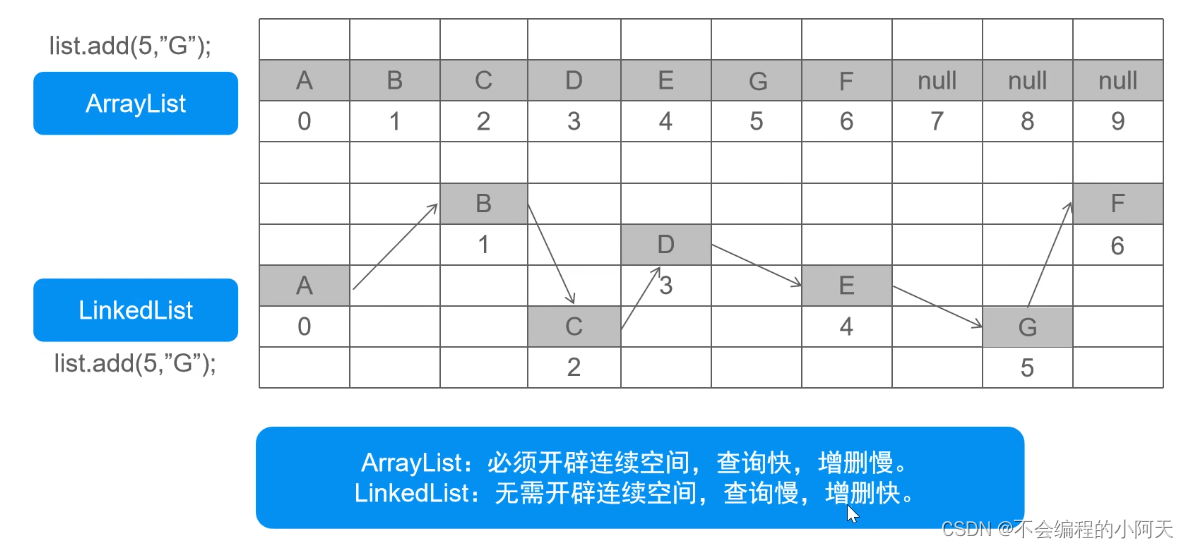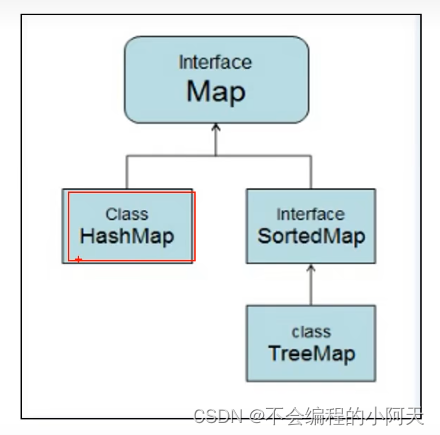集合
集合概念: 对象的容器,定义了多个对象进行操作的常用方法。可实现数组的功能。
集合和数组的区别:
(1)数组长度固定,集合长度不固定。
(2)数组可以存储基本类型和引用类型,集合只能存储引用类型
位置: java.util.*;
Collection体系集合

Collection父接口
特点:代表任意类型的对象,无序、无下标。不能重复
方法:
| boolean add(Object obj) | 添加一个对象 |
|---|---|
| boolean addALL(Collection c) | 将一个集合中的所有对象添加到此集合中 |
| void clear() | 清空此集合中的所有对象 |
| boolean contains(Object o) | 检查此集合中是否包含o对象 |
| boolean equals(Object o) | 比较此集合是否包含o对象 |
| boolean isEmpty() | 判断此集合是否为空 |
| boolean remove(Object o) | 在此集合中移除o对象 |
| int size() | 返回此集合中的元素个数 |
| Object[] toArray() | 将此集合转换成数组 |
Collection使用
//创建集合
Collection collection = new ArrayList();
// (1)添加元素
collection.add("苹果");
collection.add("西瓜");
collection.add("榴莲");
System.out.println("元素个数:" + collection.size());
System.out.println(collection);
// (2)删除元素
//collection.remove("榴莲");
// collection.clear();
// System.out.println("元素个数:"+collection.size());
// (3)遍历元素[重点]
//3.1使用增强for (无下标不能使用for)
// System.out.println("-----------3.1 增强for--------------");
// for (Object object : collection){
// System.out.println(object);
// }
//3.2 使用迭代器(迭代器是专门用来遍历集合的一种方式)
//hashNext();有没有下一个元素
//next();获取下一个元素
//remove(); 删除当前元素
System.out.println("---------------3.2使用增强for---------------------");
Iterator it = collection.iterator();
while(it.hasNext()){
String s = (String)it.next();
System.out.println(s);
// collection.remove(s); // 报错 ConcurrentModificationException
it.remove();
}
System.out.println("元素个数" + collection.size());
// (4)判断
System.out.println(collection.contains("西瓜")); //判断是否存在
System.out.println(collection.isEmpty()); //判断集合是否为空
public static void main(String[] args) {
//新建Collection对象
Collection collection= new ArrayList();
Student s1 = new Student("张三",20);
Student s2 = new Student("李四",18);
Student s3 = new Student("王二",22);
//1. 添加数据
collection.add(s1);
collection.add(s2);
collection.add(s3);
collection.add(s3);//可重复添加
System.out.println("元素个数"+collection.size());
System.out.println(collection.toString());
//2.删除
// collection.remove(s1);
// collection.remove(new Student("王二",22));//现new的删不了
// collection.clear();
//System.out.println("删除之后"+collection.size());
//3.1增强for
// for (Object objedt : collection){
// System.out.println(objedt.toString());
// }
//3.2迭代器
// Iterator it = collection.iterator();
// while (it.hasNext()){
// System.out.println(it.hasNext());
// }
//4.判断
System.out.println(collection.contains(s1));
System.out.println(collection.isEmpty());
List集合
特点:有序、有下标、元素可以重复
方法:
void add(int index,Object o ) | 在index位置插入对象o |
|---|---|
| boolean addAll(int index,Collenction c ) | 将一个集合中的元素添加到此集合中的index位置 |
//先创建集合对象
List list = new ArrayList<>();
//1.添加元素
list.add("苹果");
list.add("华为");
list.add(0,"小米");
System.out.println("元素个数为"+list.size());
System.out.println(list.toString());
//2.删除元素
//list.remove("苹果");
list.remove(0);
//list.clear();
System.out.println("元素个数为"+list.size());
//3.遍历元素
//3.1强化for
// for (Object object : list){
// System.out.println(object);
// }
// }
// System.out.println("删除后的元素个数为"+list.size());
//3.2for循环
// for (int i = 0;i < list.size();i++){
// System.out.println(list.get(i));
// }
//3.3迭代器
// Iterator it = list.iterator();
// while (it.hasNext()){
// System.out.println(it.next());
// }
//3.4列表迭代器 和Iterator区别 ListIterator可以向前向后遍历,还可以添加,删除,修改元素
ListIterator lit = list.listIterator();
//从前往后
while (lit.hasNext()){
//nextIndex() 获取下标
System.out.println(lit.nextIndex() + ":" + lit.next());
}
//从后往前
while (lit.hasPrevious()){
System.out.println(lit.previousIndex() + ":" + lit.previous());
}
//4.判断
System.out.println(list.isEmpty());
System.out.println(list.contains("小米"));
//5.获取位置
System.out.println(list.indexOf("华为"));
List实现类
- ArrayList【重点】
-
- 数组结构实现,查询快、增删慢
- JDK1.2版本,运行效率快、线程不安全
- Vector:
-
- 数组结构实现,查询快、增删慢
- JDK1.0版本,运行效率慢,线程安全
- LinkedList
-
- 链表结构实现,增删快,查询慢
ArrayList使用
//创建集合
ArrayList arrayList = new ArrayList();
//1.添加元素
Student s1 = new Student("刘德华",20);
Student s2 = new Student("郭富城",19);
Student s3 = new Student("吴彦祖",18);
arrayList.add(s1);
arrayList.add(s2);
arrayList.add(s3);
System.out.println("元素个数"+arrayList.size());
System.out.println(arrayList.toString());
//2.删除元素
arrayList.remove(new Student("刘德华",20));
//若果想直接用对应Student对象删除 remove会调用equals方法 所以只需要重写equals方法
System.out.println("元素个数"+arrayList.size());
System.out.println(arrayList.toString());
//3.遍历元素【重点】
//3.1使用迭代器
// System.out.println("------------3.1使用迭代器--------------");
// Iterator it = arrayList.iterator();
// while (it.hasNext()){
// Student s =(Student) it.next();
// System.out.println(s.toString());
// }
//3.2列表迭代器
ListIterator lit = arrayList.listIterator();
System.out.println("------------3.2列表迭代器----------------");
while (lit.hasNext()){
Student s = (Student) lit.next();
System.out.println(s.toString());
}
System.out.println("---------------3.2使用列表迭代器逆序------------------");
while(lit.hasPrevious()){
Student s = (Student) lit.previous();
System.out.println(s.toString());
}
//4.判断
System.out.println(arrayList.contains(new Student("梁朝伟",18)));
System.out.println(arrayList.isEmpty());
//5.查找
System.out.println(arrayList.indexOf(new Student("郭富城",19)));
源码分析:
arrayList源码
DEFAULT_CAPACITY = 10; //默认容量
//注意:如果没有向集合中添加任何元素时,容量是0
elementData; //存放元素的数组
size; //实际元素个数
add() //添加元素
Vector:使用
//创建集合
Vector vector = new Vector<>();
//1.添加元素
vector.add("草莓");
vector.add("芒果");
vector.add("西瓜");
System.out.println("元素个数"+vector.size());
System.out.println(vector.toString());
//2.删除
//vector.remove("草莓");
//vector.remove(0);
vector.clear();
System.out.println("元素个数"+vector.size());
System.out.println(vector.toString());
//3.遍历
//使用枚举器
Enumeration en = vector.elements();
while (en.hasMoreElements()){
String o = (String)en.nextElement();
System.out.println(o);
}
//4判断
System.out.println(vector.contains("西瓜"));
System.out.println(vector.isEmpty());
//5.Svector其他方法
//firstElement,lastElement,ElementAt();
Linkedlist使用
//创建集合
LinkedList linkedList = new LinkedList();
//1.添加元素
Student s1 = new Student("刘德华",20);
Student s2 = new Student("郭富城",22);
Student s3 = new Student("梁朝伟",18);
linkedList.add(s1);
linkedList.add(s2);
linkedList.add(s3);
System.out.println("元素个数"+linkedList.size());
System.out.println(linkedList.toString());
//2.删除
// linkedList.remove(new Student("刘德华",20));
// System.out.println("元素个数"+linkedList.size());
// linkedList.clear();
//3.1for遍历
// System.out.println("-----------for-------------");
// for (int i = 0;i < linkedList.size();i++){
// System.out.println(linkedList.get(i));
// }
//3.2增强for
// for (Object object : linkedList){
// Student s = (Student) object;
// System.out.println(s.toString());
// }
//3.3迭代器
// Iterator it = linkedList.iterator();
// while (it.hasNext()){
// Student s = (Student)it.next();
// System.out.println(s);
// }
//3.4 使用列表迭代器
System.out.println("-----------使用列表迭代器------------");
ListIterator lit = linkedList.listIterator();
while (lit.hasNext()){
Student s = (Student)lit.next();
System.out.println(s.toString());
}
while (lit.hasPrevious()){
Student s = (Student) lit.previous();
System.out.println(s.toString());
}
//4.判断
System.out.println(linkedList.contains(s1));
System.out.println(linkedList.isEmpty());
//5.获取
System.out.println(linkedList.indexOf(s2));
ArrayList与LinkedList的区别

泛型
- Java泛型是JDK1.5中引入的一个新特性,其本质是参数化类型,把类型作为参数传递
- 常见的形式有泛型类、泛型接口、泛型方法
- 语法
-
- <T,…>T成为类型占位符,表示一种引用类型
- 好处 :
-
- (1)提高代码重要性
- (2)防止类型转换异常,提高代码的安全性
泛型类的定义和使用
定义:
//泛型类
//语法 类名<T> T类型占位符,表示一种引用类型,如果编写多个使用逗号隔开
//1.创建变量
T t;
//2.泛型作为方法的参数
//不能在方法中new一个泛型对象 因为引用类型不确定
public void show(T t){
System.out.println(t);
}
//3.泛型作为方法的返回值
public T getT(){
return t;
}
使用:
//使用泛型类创建对象
//注意:1.泛型只能使用引用类型 2.不同泛型类型对象之间不能相互赋值
MyGeneric<String> myGeneric = new MyGeneric<String>();
myGeneric.t = "hello";
myGeneric.show("大家好");
String string = myGeneric.getT();
MyGeneric<Integer> myGeneric2 = new MyGeneric<Integer>();
myGeneric2.t = 100;
myGeneric2.show(200);
Integer integer = myGeneric2.getT();
泛型接口的定义和使用
定义:
public interface MyInterface<T> {
//泛型接口
//语法,接口名<T> 注意:不能泛型静态常量
String name = "张三";
T server(T t);
}
使用:
//实现接口时确定类型
public class MyIntegerfaceImpl implements MyInterface<String>{
@Override
public String server(String t) {
System.out.println(t);
return t;
}
}
//实现接口时不确定类型
public class MyIntegerfaceImpl2<T> implements MyInterface<T>{
@Override
public T server(T t) {
System.out.println(t);
return t;
}
}
//实现接口时确定类型
MyIntegerfaceImpl impl = new MyIntegerfaceImpl();
impl.server("xxxxxxxxxxxx");
//实现接口时不确定类型
MyIntegerfaceImpl2<Integer> impl2 = new MyIntegerfaceImpl2<Integer>();
impl2.server(1000);
泛型方法的定义和使用
定义:
public class MyGenericMethod {
//泛型方法
//语法 <T> 返回值类型
//泛型方法
public <T> void show(T t){
System.out.println("泛型方法"+t);
}
public <T> T show2(T t){
System.out.println("泛型方法"+t);
return t;
}
}
使用:
//泛型方法 类型不需要传递 根据给的值自动变化
MyGenericMethod myGenericMethod = new MyGenericMethod();
myGenericMethod.show("中国加油");
myGenericMethod.show(200);
myGenericMethod.show(3.14);
泛型集合
概念: 参数化类型、类型安全的集合,强制集合元素的类型必须一致。
特点:
- 编译时即可检查,而非运行时抛出异常
- 访问时,不必类型转换(拆箱)。
- 不同泛型之间引用不能相互赋值,泛型不存在多态
泛型集合的使用:
public static void main(String[] args) {
ArrayList arrayList = new ArrayList();
arrayList.add("xxx");
arrayList.add("yyy");
arrayList.add(10);
arrayList.add(20);
//Integer不能转换String 类型转换异常
for (Object object : arrayList){
String str = (String) object;
System.out.println(str);
//不同泛型不能相互指挥
ArrayList<String> arrayList2 = new ArrayList<String>();
arrayList2.add("xxx");
arrayList2.add("yyy");
for (String string: arrayList2){
String str2 = (String)string;
System.out.println(str2);
}
ArrayList<Student> arrayList3 = new ArrayList<Student>();
Student s1 = new Student("刘德华",20);
Student s2 = new Student("郭富城",22);
Student s3 = new Student("梁朝伟",18);
arrayList3.add(s1);
arrayList3.add(s2);
arrayList3.add(s3);
Iterator<Student> it = arrayList3.iterator();
while (it.hasNext()){
Student s= it.next();
System.out.println(s.toString());
}
}
}
set集合
特点: 无序、无下标、元素不可重复。
方法: 全部继承自Collection中的方法
Set实现类:
HashSet[重点]
- 基于HashCode计算元素存放位置,实现元素不重复
- 当存入元素的哈希码相同时,会调用equals进行确认,如结果为true,则拒绝而后入
TreeSet:
- 基于排列顺序实现元素不重复
- 实现了SortedSet接口,对集合元素自动排序
- 元素对象的类型必须实现Comparable接口,制定排序规则
- 通过CompareTo方法确定是否为重复元素
//创建集合
Set<String> set = new HashSet();
//1.添加数据
set.add("小米");
set.add("苹果");
set.add("华为");
System.out.println("数据个数:"+set.size());
System.out.println(set.toString());
//2.删除数据
// set.remove("小米");
// System.out.println(set.toString());
//3.遍历【重点】
//3.1使用增强for
System.out.println("-------------增强for---------------");
for (String string : set){
System.out.println(string);
}
//3.2 使用迭代器
System.out.println("-----------使用迭代器---------------");
Iterator<String> it = set.iterator();
while (it.hasNext()){
System.out.println(it.next());
}
//4.判断
System.out.println(set.contains("华为"));
System.out.println(set.isEmpty());//创建集合
Set<String> set = new HashSet();
//1.添加数据
set.add("小米");
set.add("苹果");
set.add("华为");
System.out.println("数据个数:"+set.size());
System.out.println(set.toString());
//2.删除数据
// set.remove("小米");
// System.out.println(set.toString());
//3.遍历【重点】
//3.1使用增强for
System.out.println("-------------增强for---------------");
for (String string : set){
System.out.println(string);
}
//3.2 使用迭代器
System.out.println("-----------使用迭代器---------------");
Iterator<String> it = set.iterator();
while (it.hasNext()){
System.out.println(it.next());
}
//4.判断
System.out.println(set.contains("华为"));
System.out.println(set.isEmpty());
HashSet 使用
//新建集合
HashSet<String> hashSet = new HashSet<String>();
//1.添加元素
hashSet.add("刘德华");
hashSet.add("梁朝伟");
hashSet.add("林志玲");
hashSet.add("周润发");
hashSet.add("周润发");
System.out.println("元素个数"+hashSet.size());
System.out.println(hashSet.toString());
//2.删除元素
hashSet.remove("刘德华");
// hashSet.clear();
System.out.println("删除之后"+hashSet.size());
//3遍历操作
//3.1增强for
System.out.println("------------3.1增强for--------------");
for (String string : hashSet){
System.out.println(string);
}
//3.2使用迭代器
System.out.println("--------------3.2迭代器--------------");
Iterator it = hashSet.iterator();
while (it.hasNext()){
System.out.println(it.next());
}
//4.判断
System.out.println(hashSet.contains("刘德华"));
System.out.println(hashSet.isEmpty());
//存储结构 : 哈希表(数组+链表+红黑树)
//存储过程
//(1)根据hashcode计算保存的位置,如果此位置为空,则直接保存,如果不为空执行第二部
//(2)再执行equals方法,如果equals方法为true,则认为是重复,否则,形成链表
public class Demo11 {
public static void main(String[] args) {
//创建集合
HashSet<Person> persons = new HashSet<>();
//1.添加数据
Person p1 = new Person("刘德华",20);
Person p2 = new Person("林志玲",22);
Person p3 = new Person("梁朝伟",25);
persons.add(p1);
persons.add(p2);
persons.add(p3);
//重写hashcode后 hashcode位置相同 equlas判断为false 所以两个元素数据相同但是都添加进去了‘
//重写equlas也是一样,但是两种方式都重写将不会再加入
persons.add(new Person("梁朝伟",25));
System.out.println("元素个数"+persons.size());
System.out.println(persons.toString());
//2.删除操作
// persons.remove(p1);
// persons.remove(new Person("刘德华",20));
// System.out.println("删除之后"+persons.toString());
//3.遍历【重点】
//3.1增强for
for (Person person: persons){
System.out.println(person);
}
System.out.println("-----------------------");
//3.2迭代器
Iterator it = persons.iterator();
while (it.hasNext()){
System.out.println(it.next());
}
//4.判断
System.out.println(persons.contains(p1));
System.out.println(persons.isEmpty());
}
重写hashCode和equals方法
//快捷方式alt+insert 或者鼠标右键Generate
@Override
public int hashCode() {
int n1 = this.name.hashCode();
int n2 = this.age;
return n1+n2;
}
@Override
public boolean equals(Object obj) {
if (this == obj){
return true;
}
if (obj == null){
return false;
}
if (obj instanceof Person){
Person p = (Person) obj;
if (this.name.equals(p.getName())&&this.age == p.getAge()){
return true;
}
}
return false;
}
TreeSet使用
//创建集合
TreeSet<String> treeSet = new TreeSet<>();
//1.添加元素
treeSet.add("xyz");
treeSet.add("abc");
treeSet.add("hello");
treeSet.add("xyz");
System.out.println("元素个数"+treeSet.size());
System.out.println(treeSet.toString());
//2.删除
treeSet.remove("xyz");
System.out.println("元素个数"+treeSet.size());
//3.遍历
//3.1增强for
for (String string : treeSet){
System.out.println(string);
}
System.out.println("---------------------");
//3.2迭代器
Iterator it = treeSet.iterator();
while (it.hasNext()){
System.out.println(it.next());
}
//4.判断
System.out.println(treeSet.contains("abc"));
System.out.println(treeSet.isEmpty());
//存储结构:红黑树
//创建集合
TreeSet<Person> persons = new TreeSet<>();
//1.添加元素
Person p1 = new Person("刘德华",20);
Person p2 = new Person("林志玲",22);
Person p3 = new Person("梁朝伟",25);
persons.add(p1);
persons.add(p2);
persons.add(p3);
//报错Person cannot be cast to class java.lang.Comparable 没有指定比较对象
//必须要实现Compareble接口,compareTo()方法返回值为0,认为是重复元素;
System.out.println("元素个数"+persons.size());
System.out.println(persons.toString());
//2.删除操作
// persons.remove(p1);
// persons.remove(new Person("刘德华",20));
// System.out.println("删除之后"+persons.toString());
//3.遍历【重点】
//3.1增强for
for (Person person: persons){
System.out.println(person);
}
System.out.println("-----------------------");
//3.2迭代器
Iterator it = persons.iterator();
while (it.hasNext()){
System.out.println(it.next());
}
//4.判断
System.out.println(persons.contains(p1));
System.out.println(persons.isEmpty());
Comparable接口实现(可比较的)
//Comparable是一个泛型接口
public class Person implements Comparable<Person>{
//先按姓名作比较再按年龄作比较
public int compareTo(Person o){
int n1 = this.getName().compareTo(o.getName());
int n2 = this.getAge()-o.getAge();
return n1==0?n2:n1;
}
Comparator接口(TreeSet集合的使用)实现自己定制比较(比较器)
public static void main(String[] args) {
//创建集合
TreeSet<Person> persons = new TreeSet<>(new Comparator<Person>() {
@Override
public int compare(Person o1, Person o2) {
int n1 = o1.getAge()-o2.getAge();
int n2 = o1.getName().compareTo(o2.getName());
return n1==0?n2:n1;
}
});
Person p1 = new Person("xyz",20);
Person p2 = new Person("hello",22);
Person p3 = new Person("zhangsan",25);
Person p4 = new Person("lisi",25);
persons.add(p1);
persons.add(p2);
persons.add(p3);
persons.add(p4);
System.out.println(persons.toString());
}
案例 : 要求,使用TreeSet集合实现按字符串长度进行排序
//创建集合并制定规则
TreeSet<String> treeSet = new TreeSet<>(new Comparator<String>() {
@Override
public int compare(String o1, String o2) {
int n1 = o1.length()-o2.length();
int n2 = o1.compareTo(o2);
return n1==0?n2:n1;
}
});
//添加数据
treeSet.add("helloworld");
treeSet.add("pingguo");
treeSet.add("lisi");
treeSet.add("zhangsan");
treeSet.add("beijing");
treeSet.add("cat");
treeSet.add("nanjing");
treeSet.add("xian");
System.out.println(treeSet.toString());
Map体系集合

Map父接口
特点: 1. 用于存储任意键值对(Key-Vaule)
2. 键:无序、无下标、不允许重复(唯一)
3. 值:无序、无下标、允许重复
方法:
| V put(K key, V value) | 将对象存入到集合中,取关键值。key重复则覆盖原值 |
|---|---|
| Object get(Object key) | 根据对应键获取对应的值 |
| Set | 返回所有的key |
| Collection values() | 返回包含所有值的Collection集合 |
| Set<Map.Entry<k,v>> | 键值匹配的Set集合 |
Map方法的使用
//创建Map集合
Map<String,String> map = new HashMap<>();
//1.添加元素
map.put("cn","中国");
map.put("cn","zhongguo");//同一个键 后创建的值会覆盖之前的值
map.put("china","中国");
map.put("uk","英国");
map.put("usa","美国");
System.out.println("元素个数"+map.size());
System.out.println(map.toString());
//2.删除
map.remove("usa");
System.out.println("删除之后"+map.size());
System.out.println(map.toString());
//3.遍历
//3.1 使用keySet()遍历
System.out.println("------------keySet()-------------");
Set<String> keySet = map.keySet(); //获取键的Set集合
for (String string : keySet){
System.out.println(string);
}
//3.2使用entrySet()方法 Entry表示一个键值对
System.out.println("---------------entrySet()--------------");
//Set<Map.Entry<String,String>> entries = map.entrySet();
// for (Map.Entry<String,String> entry : entries){
// System.out.println(entry);
// }
//或者
for (Map.Entry<String,String> entry : map.entrySet()){
System.out.println(entry);
//或者
System.out.println(entry.getKey()+"----"+entry.getValue());
//4.判断
System.out.println(map.containsKey("cn"));
System.out.println(map.containsValue("中国"));
}
Map的实现类:
- HashMap【重点】:
JDK1.2版本,线程不安全,运行效率快;允许用null 作为key或是value - Hashtable 【过时,不常用】:
JDK1.0版本,线程安全,运行效率慢;不允许null作为key或是value - Properties :
Hashtable的子类,要求key和value都是String。通常用于配置文件的读取 - TreeMap :
实现了SortedMap接口(是Map的子接口),可以对key自动排序。
HashMap的使用:
//存储结构 : 哈希表(数组+链表+红黑树)
//创建集合
HashMap<Student, String> students = new HashMap<>();
//1.添加元素
Student s1 = new Student("孙悟空",100);
Student s2 = new Student("猪八戒",200);
Student s3 = new Student("沙和尚",300);
Student s4 = new Student("唐僧",1000);
students.put(s1,"北京");
students.put(s2,"上海");
students.put(s3,"深圳");
students.put(s4,"北京");
students.put(new Student("沙和尚",300),"深圳");//与上方沙和尚数据一样但是加进来了
//因为使用key作为判断 hashcode和equals可能判断未重复 需要重写这两个方法
System.out.println("元素个数"+students.size());
System.out.println(students.toString());
//2.删除
students.remove(s1);
System.out.println("删除后"+students.size());
System.out.println(students.toString());
//3.遍历
//3.1使用keySet()方法
for (Student key : students.keySet()){
System.out.println(key);
}
//3.2使用entrySet()方法
for (Map.Entry<Student,String> entry:students.entrySet()){
System.out.println(entry.getKey()+"------"+entry.getValue());
}
//4.判断
System.out.println(students.containsKey(s2));
System.out.println(students.containsValue("北京"));
System.out.println(students.isEmpty());
TreeMap的使用:
//存储结构 红黑树
//创建集合
TreeMap<Student,String> treeMap = new TreeMap<>();
//1.添加元素
Student s1 = new Student("孙悟空",100);
Student s2 = new Student("猪八戒",200);
Student s3 = new Student("沙和尚",300);
Student s4 = new Student("唐僧",1000);
treeMap.put(s1,"北京");
treeMap.put(s2,"上海");
treeMap.put(s3,"深圳");
treeMap.put(s4,"北京");
System.out.println("元素个数"+treeMap.size());
System.out.println(treeMap.toString());
//2.删除
treeMap.remove(new Student("猪八戒",200));//可以删除 因为compareTo比较比较年龄
//年龄相同属性相同判定为同一对象
System.out.println("删除后元素个数"+treeMap.size());
System.out.println(treeMap.toString());
//3.遍历
//3.1 keySet()
System.out.println("------------keySet()------------");
for (Student key :treeMap.keySet()){
System.out.println(key+"---"+treeMap.get(key));
}
//3.2 entrySet()
System.out.println("------------------entrySet()----------------");
for (Map.Entry<Student,String> entry:treeMap.entrySet()){
System.out.println(entry.getKey()+"---"+entry.getValue());
}
//4.判断
System.out.println(treeMap.containsKey(s1));
System.out.println(treeMap.containsValue("北京"));
Colletions工具类
概念: 集合工具类,定义了除了存取以外的集合常用方法
方法:
| public static void reverse(List<?> list) | 反转集合中元素的顺序 |
|---|---|
| public static void shuffle(List<?> list) | 随即重置集合元素的顺序 |
| public static void sort(List list) | 升序排序(元素类型必须实现Comparable接口) |
List<Integer> list = new ArrayList<>();
list.add(20);
list.add(5);
list.add(12);
list.add(30);
list.add(6);
//sort排序
System.out.println("排序之前"+list.toString());
Collections.sort(list);
System.out.println("排序之后"+list.toString());
//binarySearch 二分查找
List<Integer> dest = new ArrayList<>();
for (int k = 0; k < list.size();k++){
dest.add(0);
}
Collections.copy(dest,list); //两个集合大小不一样 IndexOutOfBoundsException
System.out.println(dest.toString());
// reverse 反转
Collections.reverse(list);
System.out.println("反转之后"+list);
//shuffle 打乱
Collections.shuffle(list);
System.out.println("打乱之后"+list);
//补充:list转成数组
Integer[] arr = list.toArray(new Integer[0]);
System.out.println(arr.length);
System.out.println(Arrays.toString(arr));
//数组转成集合
String[] names = {"张三","李四","王五"};
List<String> list2 = Arrays.asList(names);
// list2.add("赵六"); 报错
// list2.remove(0); 报错
System.out.println(list2);
int[] nums = {100,200,300,400,500};
List<int[]> list3 = Arrays.asList(nums);
System.out.println(list3);





















 934
934











 被折叠的 条评论
为什么被折叠?
被折叠的 条评论
为什么被折叠?








